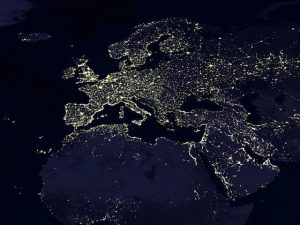 Coincidental with millions of Americans mummifying their leftover Thanksgiving turkey in cling film, a new study by researchers from Israel’s Ben-Gurion University of the Negev (BGU) says treated excrement from turkeys and chickens can provide an alternative source of energy when converted into combustible solid biomass fuel. Poultry poop biomass fuel can also reduce greenhouse gas emissions associated with agricultural waste.
Coincidental with millions of Americans mummifying their leftover Thanksgiving turkey in cling film, a new study by researchers from Israel’s Ben-Gurion University of the Negev (BGU) says treated excrement from turkeys and chickens can provide an alternative source of energy when converted into combustible solid biomass fuel. Poultry poop biomass fuel can also reduce greenhouse gas emissions associated with agricultural waste.
Biomass holds immense potential for replacing reliance on traditional fossil fuel sources, accounting for 73 percent of renewable energy production around the world. But crops grown for this purpose can harm both land and water, and divert farming from critical food production.
“Environmentally safe disposal of poultry excrements has become a significant problem. Converting poultry waste to solid fuel, a less resource-intensive, renewable energy source is an environmentally superior alternative that also reduces reliance on fossil fuels,” they said in a statement posted online earlier this month in Elsevier’s Applied Energy journal.
In the study, researchers from BGU’s Zuckerberg Institute for Water Research evaluated two biofuels – biochar and hydrochar – to determine which is the more efficient poultry waste solid fuel. They compared the production, combustion, and gas emissions of biochar, which is produced by slow heating of biomass at a temperature of 450°C (842°F) in an oxygen-free furnace with hydrochar. Hydrochar is produced by heating wet biomass to a lower temperature of up to 250 °C (482°F) using a process called hydrothermal carbonization (HTC.) This mimics the way coal is formed in a shorter time frame.
The results were clear, according to student researcher Vivian Mau, under the supervision of Professor Amit Gross, chair of the Department of Environmental Hydrology and Microbiology at Zuckerberg Institute. “We found that poultry waste processed as hydrochar produced 24 percent higher net energy generation,” she said in a statement. “Poultry waste hydorchar generates heat at high temperatures and combusts in a similar manner to coal, an important factor in replacing it as a renewable energy source.”
For the first time, researchers showed that higher HTC production temperatures resulted in a significant reduction in emissions of methane (CH4) and ammonia (NH3), with an increase of carbon dioxide and carbon monoxide.
“This investigation helped in bridging the gap between hydrochar being considered as a potential energy source toward the development of an alternative renewable fuel,” Prof. Gross explains, “Our findings could help significantly reduce greenhouse gas emissions associated with electricity generation and agricultural wastes. Field-scale experiments with HTC reactor should be conducted to confirm the assessments from this laboratory-scale study.”
Good to-know Facts About Poultry Poop
When raising chickens, there are other factors that you should take into consideration, such as the environment that you’re going to house your chickens so they can stay healthy and comfortable. This is important since chickens tend to suffer from various illnesses in outdoor environments, such as the common cold and viruses.
Keeping away poop and reusing them as a renewable energy source is a good idea to help safeguard the environment and even some, if not all, chicken breeds.
With the world’s population steadily increasing, it’s obvious that finding ways to produce a renewable energy source will become important. Unfortunately, as people are becoming concerned about environmental and resource conservation, they’re finding it harder to live a natural lifestyle. Fortunately, there are various ways to generate an unlimited source of power, one of which is by using animal poop.
Converter Kit to Generate Renewable Source of Energy
If you’re interested in converting animal waste into energy, you’ll need a converter kit. The converter can be attached to a household outlet through the use of a standard adapter.
Once you have your converter set up, the next step is to add animal waste. The easiest source of waste for the converter is grass clippings and fallen leaves. You can also find animal waste from composting toilets and industrial compost bins. The converter will then take the animal waste and convert it into usable energy.
The amount of energy that can be produced by animal waste is extremely high compared to what an electrical generator can produce. For example, a typical generator can only produce about 100 watts of power. An animal waste converter can produce 200 to 400 watts of power.
The study, published in Elsevier’s Applied Energy, was made possible through funding from the Israeli Ministry of Environmental Protection, the Rosenzweig-Coopersmith Foundation, the Israeli Ministry of National Infrastructures, Energy and Water Resources, the Rieger Foundation and the Zuckerberg Scholarship Fund at BGU’s Zuckerberg Institute for Water Research.



